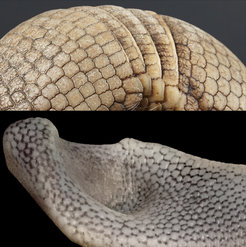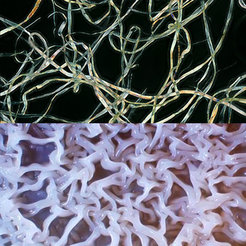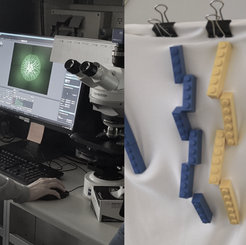Forschung
Within the cluster of excellence, the department’s current research focus is on tessellated and fibre-based materials systems and biological network connectomics. The interactions are particularly close with the cluster’s interdisciplinary projects Weaving, Material Form Function and Symbolic Materials. We work with researchers from various disciplines, including the humanities and design, to address shared research questions from a broader perspective. Our work focuses at the moment mainly on the following materials systems and concepts.
Tesselated Materials Systems

From shells to skulls to armors, tessellations are common structural motif in Nature, involving discrete architectured arrangements of soft and hard materials in geometric patterns. By combining hard tiles that offer protection with softer materials allowing dynamic flexibility, natural tessellated materials balance mechanical stability with activity, over length scales from the nano- to the macroscale.
In our project on “Tessellated Materials Systems”, in collaboration with Dr. John Nyakatura at the Humboldt University, we focus on form-function relationships in two biological systems: tessellated cartilage skeletons of sharks and rays and armadillo dermal armor. Both biological systems take advantage of architectural arrangements of soft and hard materials to dictate impressive mechanical and kinematic functions. By exploring how the combined stiffness and flexibility of shark cartilage and the rolling behavior of armadillo are encoded in their geometries, we explore the “material ecology”, contextualizing these systems in their activity. In this way, and by linking our projects with research in fibrous systems, we aim to identify general principles to be used for biomimetic and bio-informed technical solutions, e.g., in architecture, (wearables) design and in cooperation with roboticists.
Fiber-based Material Systems

Fibers can be transformed into yarns, fabrics and three-dimensional objects with new properties different to the properties of its basic component, the fiber. Driven by their structure or growth, such objects can develop various functionalities, such as the ability to fold into patterns, to swell, or to generate forces upon changes in environmental conditions.
The current research focus is on bacteria and African silk moths. Both living systems are protected by cocoons, which are permanently exposed to changing environmental conditions.
Bacteria form biofilms, which are living tissues, to protect themselves in a matrix of self-produced protein and polysaccharide fibers. The resulting woven architectures of these microbial hydrogel-like materials assure reliable properties that guarantee bacteria survival, and are studied with the perspectives of microbiology and biological materials science.
Complementary to the living system biofilm the abandoned houses (cocoons) of African silk moths are studied. Communities of caterpillars build cocoons as protective structures, which allow the development of caterpillars into moths. Traditionally, the abandoned cocoons are collected by locals who use them as a raw material for their traditional textile production amongst other uses. Anthropological studies (by Laurence Douny, Salif Sawadogo and Lossani Dayo), hint that the shape, form and function of the cocoons depends on environmental conditions but hardly anything is known about their internal structure, composition and functions.
The architectural principles employed by the bacteria for biofilm weaving and by the moths for creating their cocoon will be brought into context of textile design and cultural weaving. Further, together with architects and designers we aim to upscale our findings in an architectural context. Our knowledge on abundant biological materials such as those being plant- and bacteria-derived, will complement the expertise of these disciplines.
Science and Design
Collaborative Practices and Methodologies

The umbrella research theme deals with the interdisciplinary works from a methodological and educational perspectives. The joint research projects and educational programs within the framework of the cluster, such as our close collaboration with Weißensee Academy of Art Berlin, allows the mutual inspirations of the disciplines through exposure to the relevant disciplinary outcomes as well as their respective methodologies and processes. This lends itself to a close analysis of the practices with the aim to develop new collabo-rative methodologies and educational platforms.


